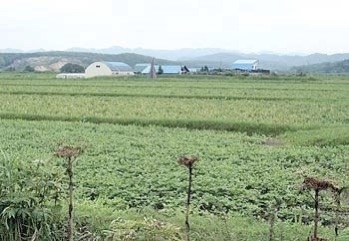































This photo contains two more riddles to be resolved. One is the type of plant in the foreground: it appears everywhere, but I've never seen it before. The second is harder to see: the teepee-like structure in the background. I've seen these in people's fields since day one of this tour, and even examined a couple at close range, and yet they seem to consist of slats of wood arranged in teepee-like fashion, with nothing in the center... and, as usual, there's never anybody around to ask. Hopefully someone will know the answer before this journey is over.
Day Four ended here, at Sarobetsu Genya - an enormous (at least for Japan) stretch of marshland that is now a nature preserve, even though people still live and work (farm) in parts. To foreign visitors, such a large expanse of relative wilderness will be nothing special. Still, for cyclists, it's an extremely pleasant place to pedal - there are several relatively untraveled roads criss-crossing the area, and at least one good place to stay (a Toho-yado called Ashita no Jo) right near one of the most beautiful sections, that serves its own Hokkaido version of nabe-ryori with meat and vegetables cooked not in water but in milk! One note: if you're on a road bike, note that the last 300m or so of the road leading to one of the large ponds, the Henke-numa, is gravel, so be sure to allow for the time needed to walk your bike there and back.



